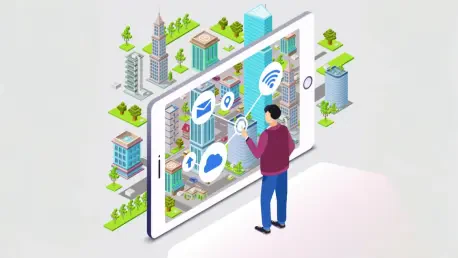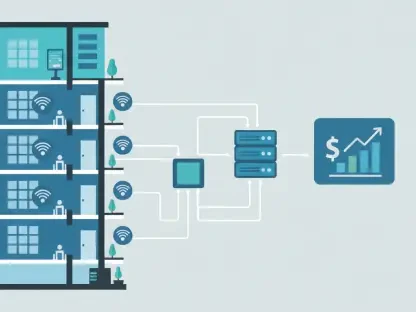As technological innovation continues to reshape various sectors, the building industry stands at the forefront of a revolution driven by hybrid security solutions. These comprehensive systems, integrating both traditional and cutting-edge technologies, pave the way for smarter, more secure environments. Organizations are strategically positioning themselves to harness the potential of digitalization in response to new threats. Hybrid solutions gain traction, and the convergence of on-premise, edge, and cloud technologies is proving to be an essential strategy to safeguard and enhance the operational efficiencies of modern buildings.
The Rise of Hybrid Security Solutions
Synergy of Traditional and Modern Technologies
Hybrid security solutions epitomize the confluence of established and emerging technologies. By combining control of tried-and-tested on-premise systems with the adaptability of cloud-based platforms, these solutions offer a balanced approach to security. The hybrid model supports the preservation of existing security investments while enabling the adoption of new technologies promising enhanced protection. Organizations no longer need to dismantle their current infrastructure; they can augment and optimize it, ensuring a smooth transition toward sophisticated security frameworks. This approach not only addresses immediate security requirements but also positions organizations to respond agilely to future threats and regulations.
A compelling aspect of hybrid solutions is their ability to offer robust control without sacrificing flexibility. Edge and cloud components work seamlessly with traditional systems, providing resilience in today’s rapidly evolving threat landscape. For instance, cloud services offer scalability and streamlined management, allowing security teams to remain proactive rather than reactive. The hybrid model enhances decision-making capabilities by integrating real-time data analytics and facilitating advanced threat detection and response mechanisms.
Strategic Future-Proofing
In a world where technological advancements occur at an unprecedented pace, future-proofing has taken center stage. Organizations must ensure that investments in security infrastructure remain relevant and adaptable. Hybrid security solutions fulfill this need by allowing gradual integration and expansion rather than necessitating potentially disruptive overhauls. This strategic approach enables businesses to align security initiatives with broader organizational goals without incurring excessive costs or operational disturbances.
Furthermore, future-proofing with hybrid solutions encompasses more than preserving current systems. It involves embracing enhancements seamlessly meshing with existing architectures. Whether integrating mobile access capabilities, remote management tools, or multi-site operations, the hybrid model ensures smooth and consistent transitions. This evolution allows companies to anticipate changes effectively, equipping them to face new challenges while solidifying their security posture.
Enhanced Maintenance and Performance
Streamlined Operations Through Automation
Hybrid security solutions offer efficiency gains through automation and remote management. Advanced systems alleviate the burden on security personnel by automating routine tasks and enabling centralized oversight. Automated diagnostics, alerts, and updates ensure systems consistently operate at peak performance, minimizing downtime and maximizing resource allocation. These efficiencies translate into significant cost savings over time, reinforcing the business case for adopting hybrid models.
Automated processes enhance the overall security posture of an organization. With unified alarm and workflow management, security teams can focus on strategic priorities rather than operational minutiae. AI-driven analytics provide actionable insights, allowing informed decision-making and swift response to potential threats. This synergy represents a paradigm shift in how organizations perceive and implement building security strategies, elevating them to a proactive stance.
The Role of Data Visualization
Data visualization has emerged as a pivotal component of hybrid security solutions, transforming how organizations interpret and act upon security data. The integration of sophisticated cloud-based analytics tools enables the assimilation of vast amounts of data, translating it into actionable visuals. This capability is invaluable, particularly in multi-site environments where situational awareness is vital. By offering real-time dashboards and analytics, hybrid systems empower security managers to identify patterns, trends, and anomalies.
Data visualization extends to operational decision-making, where insights derived from analyses enhance resource optimization and strategic planning. Whether forecasting security risks or identifying areas for improvement, this functionality equips organizations with the intelligence needed to refine security operations. As industry regulations and threat landscapes evolve, the ability to visualize and interpret complex data sets remains crucial to maintaining resilient security frameworks that adapt to any challenge.
The Critical Role of Cybersecurity
Cloud-Enabled Cybersecurity Enhancements
The complexity of the threat landscape necessitates integrating cloud-enabled cybersecurity measures into hybrid security solutions. The sophistication of cyber threats requires advanced protective measures beyond conventional boundaries. Cloud-based systems are adept at providing real-time threat detection and response, facilitating timely security patches and updates. This ensures systems remain fortified against evolving threats while maintaining compliance with regulatory standards.
Cloud services contribute significantly to improving the cyber resilience of hybrid architectures. Leveraging cloud connectivity, organizations benefit from enhanced threat intelligence and collaborative security frameworks. The collaborative nature of cloud solutions facilitates sharing threat data and best practices across industries, creating a collective defense mechanism. Consequently, organizations employing hybrid models are better positioned to anticipate, respond to, and mitigate potential cyber incidents.
Navigating Regulatory Compliance
Modernizing building security systems through hybrid models aligns with the evolving regulatory landscape surrounding cybersecurity. New directives demand rigorous adherence to security standards, mandating robust measures and ongoing compliance. Hybrid solutions integrate continuous monitoring and reporting functionalities that simplify the compliance process.
Adopting a hybrid approach allows organizations to address regulatory demands proactively. Establishing dynamic security frameworks accommodates current regulations and future requirements, helping companies avoid costly penalties and reputational damage associated with non-compliance. Regular system updates and audits facilitated by cloud-enabled tools ensure accurate records, compliance demonstrations, and seamless security posture adaptations as regulations evolve.
Smart Buildings and Emerging Capabilities
Intelligent Building Systems
Hybrid security solutions mark a new era in smart building evolution. These systems offer a comprehensive suite of intelligent functions that analyze and enhance operational efficiencies. Integrating AI-based technologies enables buildings to become smarter, predicting and responding to environmental changes in real-time. This capability improves security outcomes, sustainability, and energy efficiency, aligning with broader organizational goals.
Intelligent security infrastructures initiate a shift toward proactive building management, where data-driven insights dictate strategic decisions. Predicting equipment failures, optimizing energy usage, and automatically adjusting to occupancy levels exemplifies hybrid solutions’ potential. These transformative capabilities translate into tangible benefits, including cost savings and enhanced tenant satisfaction. Moreover, as smart buildings leverage hybrid technologies, the line between security and operational efficiency blurs, offering a holistic approach to building management.
Seamless Integration and Innovation
A key advantage of hybrid security solutions in smart building evolution is their adaptability in diverse environments and complex infrastructures. Gradual adoption of advanced technologies allows organizations to innovate without disruption, enhancing capabilities incrementally.
The convergence enabled by hybrid solutions maximizes the potential of IoT devices within buildings. Integration fosters an environment where data flows freely between systems, using predictive analytics to improve safety, comfort, and efficiencies. The interplay between IoT and hybrid infrastructures bolsters security and spurs innovation, driving new, responsive building applications transforming operations.
Charting the Path Forward
Embracing Resilient Security Frameworks
As digitalization continues, resilient security frameworks become critical. Hybrid security solutions represent strategic investments in future-proofing buildings to withstand technological changes. This approach aligns with the necessity for comprehensive, integrated solutions addressing multifaceted challenges in current and emerging threats.
Organizations prioritizing resilient frameworks position themselves for success. Focusing on strategic innovation allows integration of new technologies, advancement of objectives, and enhancement of building environments. Hybrid solutions ensure organizations effectively respond to threats while thriving in a competitive marketplace.
Looking Ahead
In an era where technological innovation continually redefines industries, the building sector finds itself at the forefront of a transformation driven by hybrid security solutions. These comprehensive systems seamlessly blend traditional security measures with advanced technologies, setting the stage for more intelligent and secure environments. As organizations adapt to this new landscape, they are not merely reacting to emerging threats. Instead, they are strategically leveraging digital advances to unlock the full potential of their operations. The rising popularity of hybrid security solutions marks a significant shift as the integration of on-premise, edge, and cloud technologies becomes essential. This convergence is not just an evolutionary development but a strategic necessity designed to safeguard and optimize the operational efficiencies of modern buildings. By embracing these advanced security measures, organizations can ensure both heightened protection and enhanced functionality, positioning themselves advantageously in an increasingly digital world.









